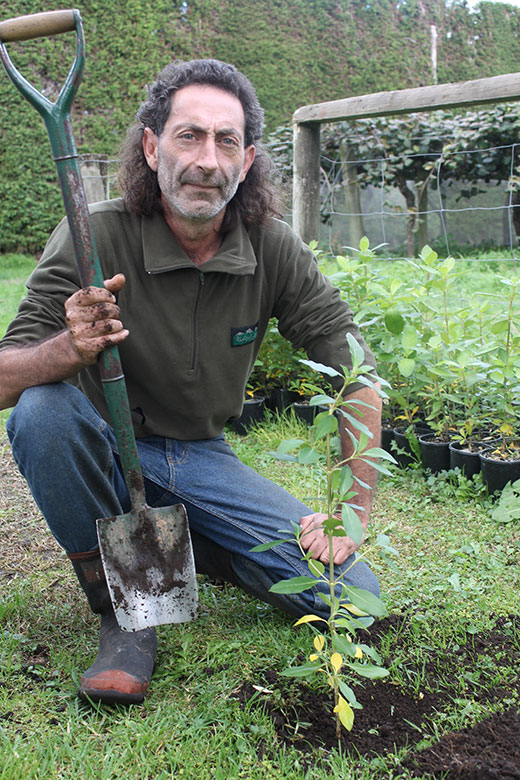It didn’t take Barry Stent long to figure out it’s not easy to dig round holes with a square spade, so he adapted a round shovel for the job.

Round spade for round hole – Barry Stent with the spade he adapted for tree planting.
“The only round shovel I could find was a trenching one, so I cut the blade off to 12 inches, which is the ideal depth for seedlings and it works fine,” says Barry, of Future Environments.
Finding ways of working smarter is what Barry is good at – and the man who has planted tens of thousands of trees in recent years needs ways to make the job more efficient.
Barry has been a contractor for the former Environment Bay of Plenty (now Bay of Plenty Regional Council), and today works for a number of private clients; planting areas of wetlands and waterways retired from farming to improve water quality.
Awards for design
He’s designed and planted large areas of two award-winning farms – the Kaimai dairy farm owned by the McFetridge Family, which won the supreme 2013 Ballance Farm Environment Award, and Pukekauri Farms owned by Rick Burk and the Seddon Family, which won the same award this year.
Today Barry does most environmental planting on his own, but when he employed staff the first thing he taught them was how to dig a hole.
“They used to laugh when I said I’d teach them how to dig a hole, but not many people know how to dig holes properly.”
Getting the hole right is just one of the steps to ensuring young native trees and shrubs will survive when re-planted, says Barry.
“The first step is to buy good quality plants from a top nursery. I only buy plants from Treeline Native Nursery because their plants are top quality.”
The second step is to pick up only three to four seedlings at a time when carrying them.
“You can easily hold up to four seedlings at one time and they will be straight up and down – but as soon as you pick up more, stress comes on the roots because they are pulled to one side, damaging the roots.”
It’s not immediately obvious but over time, uneven root growth can lead to trees falling over in strong winds. “We are seeing some areas, which have been planted for several years, showing these problems now.”
It seems entirely obvious, but removing the plants from their plastic bags is another essential.
“I was once asked to find out why up to 700 recently-planted trees were dying. It was thought they might have a root disease – but no – they were still in the bags,” says Barry.
It’s easier, Barry says, to dig a large rather than a small hole – so he digs one foot by one foot (30cm by 30cm) holes, breaking up the dirt at the bottom and giving the top layer a good chop with his round spade.
Then it’s a quick slap against his thigh to loosen both the plastic bag and the dirt, a quick shake to free up the roots, and into the hole goes the plant.
“Push the dirt in around the plant with your hands. New Zealand natives don’t like air around their roots, and pushing the dirt down also helps keep them secure.”
Pukeko proof
Barry uses a different method for planting grasses. It’s designed to stop pukeko pulling them out.
“You dig a slit in the ground on an angle, hold the plant in your hand and slide the roots into the dirt, tucking them up and under, which makes it pretty hard for the pukeko to get them out.”
Barry prefers to use a weed eater to remove pest plants from around young trees.
“New Zealanders use far too many chemicals on the land; and we are all paying the price with effects on our health.”



0 Comments
Leave a Comment